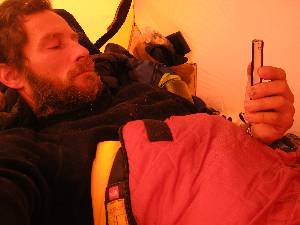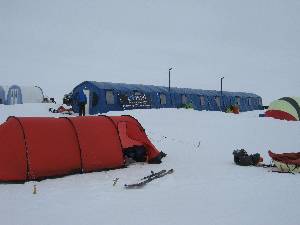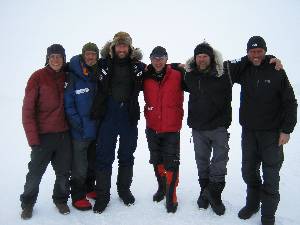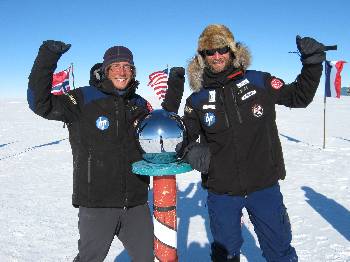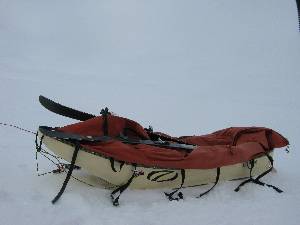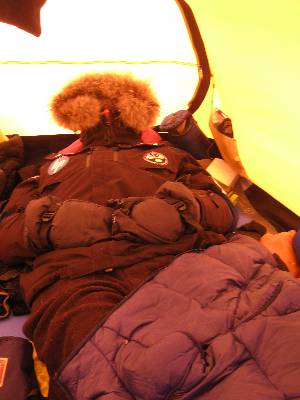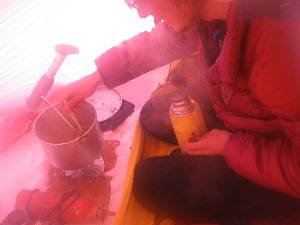January 5, 2012
S88°38.809 E015°18.869
Elevation 8984 feet
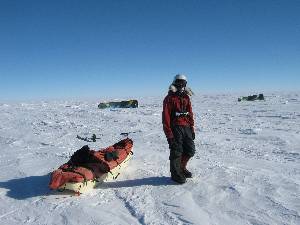
“Eric, let’s keep going!”, I said as he was walking to his kite to wrap it for the day. “Who knows if we’ll ever score conditions like these again?”, I insisted.
“Okay, sure”, he simply replied.
It was 2 AM. We had left the tent at 11:30 the previous morning, in what was already a long day. In a sense, sleeping for me had lost some its appeal. The fact that I no longer had a sleeping bag was only one of the many ironies of that day.
To get out of the tent and hit the trail when it is blowing snow and the cold gets a hold of your fingers almost instantly is losing its appeal–if it ever had one. For the both of us, especially after long traveling days, fatigue and soreness is taking its toll on our ability to spring out. Even on a windy day like this one. Besides, we had left the seventy five meters of line unwind last night, and the wind was too strong for the Yakuza’s; our first order of the day was the anti-climactic ten minutes of winding and wrapping the big guns before laying out the next size down. Just enough to let the cold get a grip on you! For that reason, we chose to leave the tent up, and seek shelter once this was done, just long enough to psyche ourselves up again. When we did leave, riding big with the thirteen meter Frenzy’s in about twenty knots, we shot out like a pinball for a wild and adrenaline fueled ride! In the gusts, the accelerations reached forty kilometers per hour, our fastest speed on this trip. The sledges were bucking and bouncing all over the place, sometimes flying, sometimes rolling a full three-sixty, and sometimes tipping which requires landing the kite to re-set. The sights were unlike anything we had experienced thus far. Haze in the air was robbing the horizon line, but the sun’s soft, warm light was defining the terrain which, thankfully for our speeds, was remarkably flat.
For long stretches, much of the sastrugi had gone in what was by far, the best conditions we have experienced. I had to film this! On our next break, Eric came to my sledge to check on our speed. We were both excited: thirty five kilometers for the hour, including the “tip stops”! I had Eric help me set a camera on my helmet, and we were off. As I filmed Eric, I weaved back and forth, fish-tailing the sledge which erratically bounced around like a quarter in the dry cycle! On our next stop, I walked to my sledge and immediately noticed that the storage area in the front had flattened considerably. Could it be that the pounding had compressed the cargo to that extent? In quick succession, I realized that my front zipper was only partially closed. And almost instantly understood that the flat area meant things were missing! “My sleeping bags are gone!”, I shot out to Eric. “The zipper was left open.” Both my Western Mountaineering minus 25C bag, and the over bag were gone! The rodeo had ejected them out somewhere in a thirty kilometer stretch of this desolate part of Antarctica, where they now sat, in the blowing snow, getting half buried. “I’ll go back, and see how much Indian blood I have in me,” Eric immediately offered. Give him a scent, and he does have a hound in him. “It’s no use, let’s go!” I said. “It would be like looking for a pin in a hay stack.” In reality I was shocked. “It’s your sleeping bag, man. Unless you want to cuddle. Besides I found that camera on Greenland.” Last year on Greenland, he successfully backtracked a section to recover a small camera that had fell off the sledge during filming when the center column of my tripod had loosened up. With that, he was gone amidst the blowing snow. I set up the tent thinking, of the two of us, he was the best man for that job. An hour passed. It suddenly occurred to me that, that morning, while riding, for absolutely no reason that made any sense whatsoever, I had had an imaginary conversation with no one in particular boasting that with three months on the ice, I had not lost a single item! Not once during the trip had such a thought entered my mind, nor is it a consideration which I have previously entertained! I don’t typically lose things. And here we were… How ironic! Aside from the bags, I also lost the first aid kit which is even more valuable to me now for the dressing materials of my toes. That, and ten days’ worth of Herbalife protein powder, as well as some lose bars.
Another hour passed. I contemplated the nature of ambition. Could it be that the desire and excitement to get the best shots, in some of the toughest conditions, had me blinded to the basics of life, such as zipping up your sledge before going? Is this something I should factor in for other areas of my life? In the following hour, I dozed off in spite of the chill that gnawed at my bones. I woke up hungry, and stepped out to the sledge. The wind had dropped considerably. I was frustrated with the lost mileage for the day in such epic conditions. I looked up, and on the horizon, noticed Eric’s kite. He was a good ten minutes away. I crawled back in the tent. When I heard his skis, I jumped out, but my heart immediately sunk. “No luck, eh?”, I let out, quickly scanning him for extra cargo. “No. I got to our last break, but nothing,” he replied. “I had to tack upwind to backtrack. Besides, the light of the sun from this direction made it hard to see things,” he added.
“Well, at least it wasn’t the camera bag!” I said. I meant it. Inside had all the pictures and film files of the trip. In a sense, my angel was still sitting on my shoulder. Besides, we are dropping in elevation like a lead balloon, (3220 feet since the POI) and the temperatures, in the tent especially, are noticeably warmer. Who needs a sleeping bag? I guess I’ll sleep in my big, cold weather Napapijri jacket.
We laid out the big kites, hoping to make the best out of the dying winds. It was 19:30.
The terrain suddenly smoothed out, almost completely, and the ice cover softened. I was praying for the winds to hold, and they were! We were making over twenty kilometers per hour, with another sample of incredibly consistent winds; they just wouldn’t let up. The day had started epic; taken a turn for the worst; and was now setting up to be our best traveling day yet! At the same time–another irony– while we experienced, by far, the best terrain condition of the trip (reminiscent of Greenland surfaces), my ankle and knee were starting to give me serious trouble. Go figure.
From the modest hope of getting us some decent mileage to make up for the lost afternoon, I found it difficult to turn it in. Besides, without a sleeping bag, sleeping had lost some of its incentive! We were doing thirty minute sections, and after each one, my knees and ankle were giving me a serious taste of old age. I had difficulty walking. Eric’s knee was also beginning to feel it. But we kept adding one more section.
The Antarctica ice had never looked so glorious. Flat as the surface now was, and through the tint of my Revo’s, the white looked tanned, and the vast expanse of ice looked like an endless beach. The surface had turned to soft snow, with large, diamond like shining crystals. The temperature was remarkably warm. The day had started with my silhouetted shadow in front of me to the left; it was now in front of me to my right. The sun had circled around us over the horizon all day. It was 06:30 in the morning, and my joints finally called in the day. Our best day, as it ironically turned out. Life had handed its full gamut, but was ending on the bright side! We covered 228.5 kilometers which put us within striking distance of the Pole.
The POI-SP section has–so far, and but for three days in the tent–delivered the most consistent winds of the entire trip. We have logged in big days of travel, covering 540 kilometers in the last three days alone! This brings our total for the trip so far to 2500 kilometers. We expect to close the gap to the pole in the next day or two, bringing successful completion to the second mandate of this mission.
More


